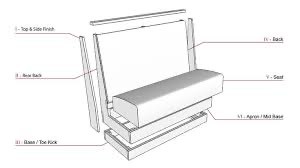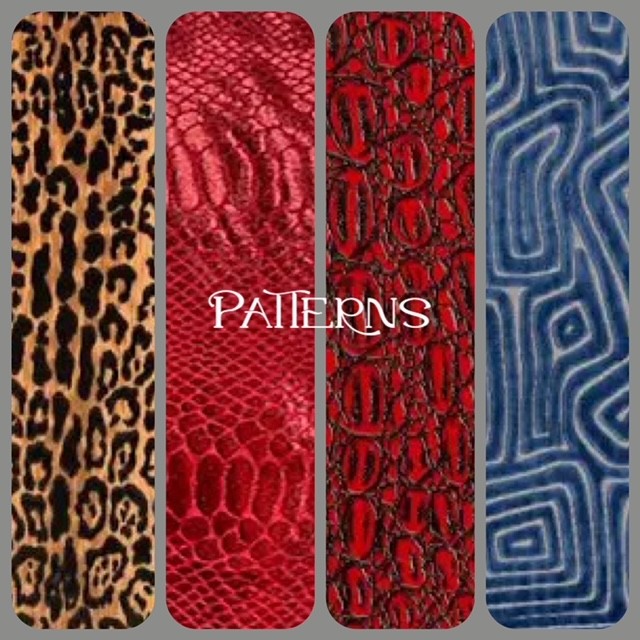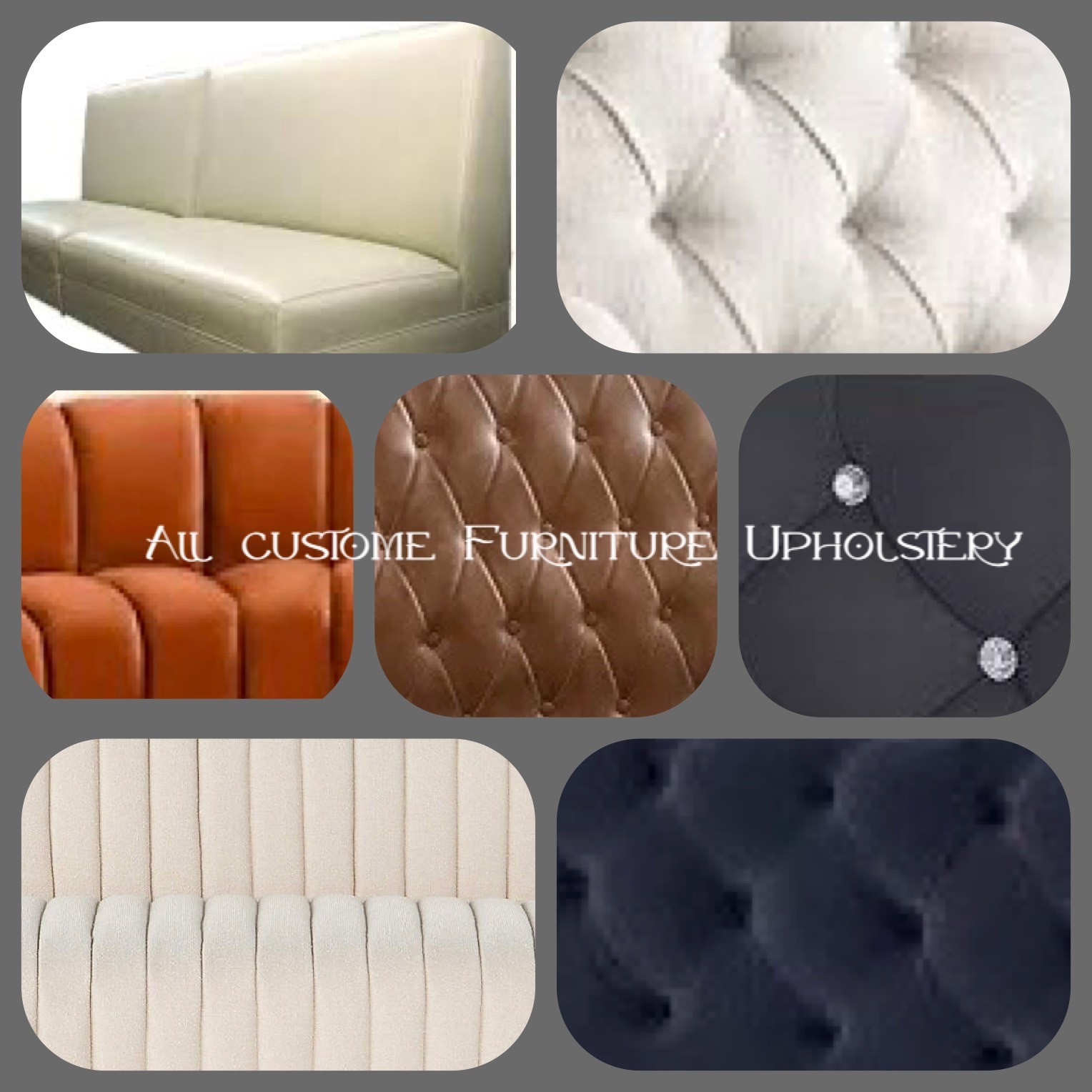Booth seating in a restaurant offers guests a cozy and intimate dining experience. It not only enhances comfort and privacy but also plays a significant role in the overall aesthetic. The design and arrangement of booth seating can complement the restaurant's theme, create a welcoming atmosphere, and encourage longer stays. Additionally, booths can be more efficient in utilizing space, allowing for a better flow of movement within the dining area. Overall, they are a vital element in balancing functionality and style in restaurant interiors.
Booths can be tailored to fit the specific layout and style of any restaurant, whether it’s a quick-service spot or an upscale fine dining establishment. Their customizable nature allows for adjustments in size, shape, and materials, ensuring they align perfectly with the overall design vision.
In quick-service restaurants, booths can promote quicker turnover while providing guests with a comfortable place to enjoy their meals. For fine dining, booths can create a more intimate atmosphere, allowing for privacy while enhancing the overall experience. Additionally, the variety of upholstery and finishes available means that booths can seamlessly integrate with any aesthetic, from modern to rustic. This versatility makes them a fantastic choice for maximizing both functionality and style in any dining environment.
When designing restaurant booths, it’s essential to consider both form and function to fully leverage their benefits. Starting with the dimensions, you can choose sizes that fit the space while accommodating the desired number of guests. Customizing the height and depth can enhance comfort and create a more inviting environment.
The upholstery selection also plays a crucial role. Choosing durable, easy-to-clean fabrics can ensure longevity, while colors and patterns can reflect the restaurant's theme. Additionally, integrating features like built-in lighting or charging ports can elevate the functionality of booths, making them more appealing to guests.
By thoughtfully designing booths that balance aesthetics with practicality, you can create a welcoming atmosphere that encourages customers to return, while also optimizing the layout and flow of the dining space. This strategic approach can transform booths from mere seating arrangements into standout features of the restaurant's interior design.
The Construction of A Booth
Understanding the basic elements that comprise a well-made restaurant booth is crucial before diving into the design process. Here are the key components to consider:
Frame Construction:
Materials: Commonly wood or metal, the frame must be durable and stable to support the booth’s structure.
Design: Consideration for how the frame will integrate with the overall design aesthetic.
Seating Surface:
Bench Seat: Should be designed for comfort, typically with a padded surface. The depth and height are important for guest satisfaction.
Backrest: A well-designed backrest provides support and can be contoured for added comfort.
Upholstery:
Material Selection: Durable, easy-to-clean fabrics are essential, especially in high-traffic areas. Options can include vinyl, leather, or specialized textiles.
Padding: Adequate cushioning is important for long dining experiences, so consider the thickness and quality of padding.
Table Design:
Attachment: Decide if the table will be fixed to the booth or movable, which can affect the overall flexibility of the seating arrangement.
Surface: Choose materials that complement the booth’s aesthetic while being easy to maintain.
Dividers and Partitions:
Privacy Features: Incorporating partitions can enhance the dining experience by providing guests with a sense of privacy.
Material and Height: Ensure dividers are visually appealing and do not obstruct sightlines unnecessarily.
Dimensions:
Standard Measurements: Familiarize yourself with types to ensure comfort and accessibility. Custom sizes may be needed depending on the restaurant layout.
Finishing Touches:
Surface Treatments: Consider finishes that enhance durability and aesthetics, such as stains or protective coatings.
Detailing: Additional design elements like trim, color schemes, and decorative accents can elevate the booth’s look.
Accessibility Considerations:
Ensure that booth designs comply with accessibility standards, allowing for comfortable use by all guests.
By being familiar with these basic elements, you can create custom restaurant booths that are not only functional and comfortable but also enhance the overall dining experience. This foundational knowledge is vital for ensuring that your designs meet the needs of both the restaurant and its guests.
A skilled manufacturer can bring your vision to life while ensuring the highest quality materials and craftsmanship. They can provide valuable insights into ergonomics, durability, and style, helping you create booths that not only look great but also stand up to the demands of a busy restaurant environment.
Moreover, a knowledgeable partner can help customize booths to fit your specific space and aesthetic, ensuring that every detail aligns with your brand. This collaboration can lead to a seating solution that enhances the guest experience, maximizes space efficiency, and contributes to the overall ambiance of the restaurant. Investing in a skilled manufacturer ultimately pays off in both functionality and design, making it a crucial step in the booth design process.
1} The strip placed on the very top of the booth as well as on the left and right side
2} The soft cushioning to provide comfort and back support for our guest.
3} The base is the foundation of the entire booth that's what it rests on.
4} A back panel that runs side to side
5}The seat portion of the booth
6}The seating layer support

Customizing a restaurant booth can enhance the overall ambiance and improve the dining experience. Here are some elements you might consider adding:
Upholstery Choices: Different fabrics or leather options can create varying textures and aesthetics.
Color Schemes: Using specific colors can help set the mood—warm colors for a cozy feel or cool colors for a more modern vibe.
Lighting: Adding pendant lights or LED accents can create a welcoming atmosphere.
Privacy Features: High backs, partitions, or curtains can provide a sense of seclusion.
Artwork: Incorporating local art or themed decorations can enhance the character of the space.
Tables: Custom table shapes or materials can complement the booth design.
Accessories: Adding cushions, throws, or decorative pillows can make booths more inviting.
Plant Life: Incorporating greenery
or floral arrangements can bring life to the space.
Technology: Integrating charging stations or tablet menus can modernize the dining experience.
Footrests: Adding footrests can increase comfort for diners.
Each of these elements can help tailor the booth to fit the restaurant's theme and enhance customers.
Design Your Booth Just For You In 5 Easy Steps
The primary purpose of a restaurant booth is to offer comfortable seating for guests, creating a relaxed and inviting atmosphere. This type of seating can enhance the dining experience by providing:
Privacy: Booths often create a sense of enclosure, making diners feel more intimate and less exposed.
Comfort: The design usually features padded seats and backs, allowing for longer, more enjoyable meals.
Space Efficiency: Booths can maximize seating capacity while maintaining a cozy environment.
Accessibility: Many booths are designed to accommodate various group sizes, making them versatile for couples, families, or larger parties.
Aesthetic Appeal: Booths can be styled to complement the restaurant's theme, contributing to the overall ambiance.
Overall, a well-designed booth enhances the dining experience by combining comfort, style, and functionality!
Select A Body Layout
When selecting a booth frame, it’s essential to consider various styles that align with your restaurant's theme and functionality. Here are some common frame styles you might encounter:
Traditional Frames: Often made of solid wood, these frames provide a classic look and durability. They can be stained or painted to match your décor.
Metal Frames: Sleek and modern, metal frames can offer an industrial feel. They’re typically durable and easy to clean.
Upholstered Frames: These frames includ
e padded backs and sides for added comfort. They can be customized with different fabrics and colors.
Modular Frames: These are versatile and can be configured in various ways, allowing for flexibility in seating arrangements.
High-Back Frames: Providing extra privacy, high-back booths are perfect for creating an intimate dining experience.
Corner Booths: Designed to fit in corners, these frames can maximize seating in smaller spaces.
Custom Designs: If you’re working with a manufacturing partner, consider collaborating on custom frames that reflect your unique vision and brand identity.
When choosing a frame, think about durability, maintenance, and how well it fits into your overall design concept. Each style can greatly impact the ambiance and comfort of your restaurant
Select Height and Length for Your Booth
Selecting the length and height of your booth is crucial for both comfort and functionality. Here are some guidelines to consider:
Length:
Standard Lengths: Booths typically come in standard lengths, such as 4, 6, or 8 feet. Choose a length based on your expected group sizes:
4 Feet: Ideal for two to four guests.
6 Feet: Comfortable for four to six guests.
8 Feet: Suitable for larger groups, accommodating six to eight guests.
Customization: If standard sizes don’t meet your needs, consider custom lengths that fit your space perfectly.
Height:
Standard Heights: Most booths have a height of around 30-36 inches for the seat. For the backrest, consider:
Standard Height: 36-42 inches, providing adequate back support.
High-Back Booths: 42 inches or taller for more privacy and comfort.
Consider the Table Height: Ensure the booth height complements the table height. Standard dining tables are typically around 28-30 inches high, so the seat height should allow for comfortable legroom.
Accessibility: If your restaurant will serve guests with varying mobility needs, consider incorporating booths with adjustab
le heights or lower seating options.
Ultimately, the length and height should enhance the dining experience while fitting seamlessly into your restaurant's layout and design.
Types of Booths
Here’s a breakdown of different booth types, along with their characteristics and ideal uses:
1. Single Booth
Description: Typically seats two to four guests, featuring one backrest and two sides.
Ideal For: Couples or small parties. Great for intimate dining experiences.
2. Double Booth
Description: Similar to a single booth but larger, usually accommodating four to six guests with backrests on both sides.
Ideal For: Families or small groups looking for more space and comfort.
3. Banquette
Description: A long bench seat along a wall or partition, often with a table in front. Can be upholstered or hard surface.
Ideal For: Larger groups, flexible seating arrangements, and maximizing space. Great for casual dining or brunch settings.
4. U-Booth
Description: A booth shaped like a "U," with seating on three sides and typically a table in the center.
Ideal For: Groups of six or more, offering a cozy and intimate setting. Perfect for families or friends wanting a more communal dining experience.
5. Half-Circle Booth
Description: A curved booth design that provides seating in a semicircular shape, often with a table in the center.
Ideal For: Smaller groups or c
ouples looking for a unique and inviting seating option. The design fosters conversation and connection.
Considerations
When choosing the type of booth, consider:
Space Availability: Ensure there’s enough room f
or movement and service.
Group Size: Think about the typical party sizes you’ll accommodate.
Design Aesthetic: Choose a style that aligns with your restaurant's theme and ambiance.
Each booth type offers unique benefits, so think about what best fits your space and customer experience goals!
Choose A Foundation
Choosing a booth base is an important step, as it affects both stability and style. Here are some common booth base options to consider:
1. Wooden Base
Description: A solid wood base provides durability and a classic look. It can be stained or painted to match the overall décor.
Pros: Sturdy, aesthetically pleasing, customizable finish.
2. Metal Base
Description: Metal bases are often sleek and modern, providing an industrial feel. Common materials include steel or aluminum.
Pros: Strong, lightweight, and easy to clean. They can also add a contemporary touch.
3. Upholstered Base
Description: An upholstered base adds co
mfort and can enhance the booth’s aesthetic. This option allows for a variety of fabric choices.
Pros: Soft and comfortable, provides a cozy atmosphere.
4. Vinyl Base
Description: Vinyl-covered bases are practical for high-traffic areas and can be easily cleaned. They come in various colors and textures.
Pros: Durable, low maintenance, and resistant to spills.
5. Composite Base
Description: Made from engineered materials, composite bases can mimic the look of wood or metal while being more affordable.
Pros: Cost-effective, lightweight, and can be designed to fit any style.
Considerations
Durability: Ensure the base material can
withstand the wear and tear of daily use.
Maintenance: Choose a base that is easy to clean and maintain, especially in a busy restaurant setting.
Aesthetic: Select a base that complements the overall design of your restaurant.
Ultimately, the choice of booth base should align with your restaurant’s theme, target audience, and practical needs!
Choosing Your Magic Touch
Choosing an upholstery style for your restaurant booth is key to creating the right ambiance and ensuring comfort. Here are some factors to consider:
1. Fabric Types
Vinyl: Durable and easy to clean, ideal for high-traffic areas. Available in various colors and textures.
Leather: Offers a luxurious feel and is also easy to wipe down. Real leather is more expensive, while faux leather can be a more budget-friendly option.
Fabric: A wide range of options, including cotton, polyester, and blends. Choose patterns or textures that match your restaurant's theme, but keep in mind they may require more Maintenace

2. Texture
Smooth: Provides a sleek, modern look and is easy to clean.
Textured: Adds depth and interest; however, textured fabrics may be harder to clean and maintain.
Patterned: Can enhance the visual appeal and add character. Ensure patterns align with your overall design aesthetic.
3. Color
Neutral Tones: Great for creating a calming atmosphere and easily matches different design styles.
Bold Colors: Can make a statement and add vibrancy, but may show wear more quickly.
Patterns: Consider geometric designs or floral patterns to create a unique look but ensure they dont clash with other elements in your space.

4. Durability and Maintenance
Stain Resistance: Look for fabrics treated for stain resistance, especially in family-friendly or casual dining settings.
Wear Resistance: Check the fabric’s rub count; a higher count indicates better durability for high-traffic areas.
5. Comfort
Padding: Ensure the upholstery is well-padded for comfort, especially if diners will be seated for extended periods.
Cushioning: Consider different types of cushioning materials (foam, gel) for added comfort and support.
6. Style
Contemporary: Sleek and minimalistic fabrics fit modern restaurants.
Traditional: Rich, textured fabrics may suit more classic or vintage-themed establishments.
Eclectic: Mix and match styles for a unique, artsy vibe.
By carefully considering these factors, you can select upholstery that enhances your restaurant’s atmosphere while ensuring com
fort and durability for your guests!
Choose Your Style
When selecting upholstery styles for restaurant booths, each design offers unique aesthetics and comfort features. Here’s a breakdown of the options you mentioned:
1. Smooth Back
Description: A clean, seamless design without any added textures or patterns.
Pros: Modern and sleek, easy to clean, and versatile. It can fit well in various design themes.
2. Vertical Channel Style
Description: Features vertical seams or channels running along the backrest, creating a ribbed appearance.
Pros: Adds texture and visual interest while maintaining a streamlined look. It can enhance comfort by providing subtle support.
3. Head Roll
Description: Includes a cushioned roll at the top of the backrest for additional neck support.
Pros: Offers extra comfort, particularly for diners who may lean back. It adds a touch of elegance and sophistication.
4. Floating Button Designs
Description: Involves buttons that are tufted into the upholstery but appear to "float" due to the way they are attached.
Pros: Creates a stylish, modern look with a bit of depth. The buttons can add character without overwhelming the design.
5. Diamond Tufted Design
Description: Characterized by diamond-shaped patterns created by stitching buttons into the fabric, resulting in a plush and classic look.
Pros: Timeless and luxurious, this design enhances comfort while providing a strong visual statement. It works well in both upscale and cozy settings.
Considerations
Theme Compatibility: Choose a style that complements your restaurant's overall theme and atmosphere.
Comfort Level: Ensure that the chosen design provides adequate support for guests, particularly if they will be seated for extended periods.
Maintenance: Some designs may be easier to clean and maintain than others, so consider your restaurant's traffic and potential wear.
By selecting the right u
pholstery style, you can create an inviting and comfortable dining environment that enhances the overall experience for your guests!

